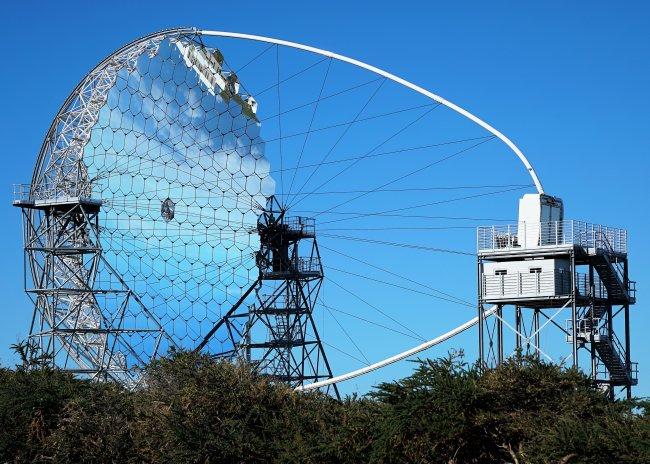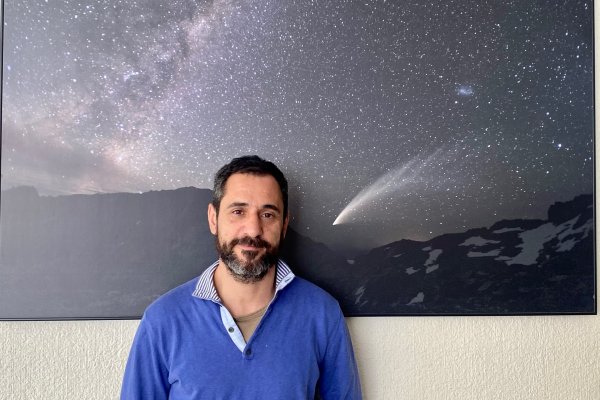Pol Bordas, researcher from the High Energy Astrophysics group at the Institute of Cosmos Sciences of the University of Barcelona and the Institute of Space Studies of Catalonia (ICCUB-IEEC), has been recently designated as the deputy Physics Coordinator of the Large-Sized Telescope (LST) Collaboration, marking a significant milestone in his scientific career.
In the next years, Dr. Bordas will play a pivotal role in shaping the scientific direction of the collaboration, facilitating the interdisciplinary cooperation among the different working groups and laying out their strategic research topics, in alignment with the overall CTAO’s science case. His appointment as Deputy Physics Coordinator represents a significant endorsement of his scientific trajectory in the field and of his proven expertise and leadership skills.
The LST Collaboration is an international consortium of leading research institutions responsible for the design and construction of the Large-Sized Telescopes (LSTs), one of the three classes of telescopes required to cover the Cherenkov Telescope Array Observatory (CTAO) energy range, from 20 GeV to 300 TeV. Four LSTs will be arranged at the centre of the CTAO’s northern hemisphere array, located on La Palma (Spain), and an enhancement plan of the current layout includes also two LSTs in the southern array in the Atacama Desert (Chile).
The LSTs are optimized to cover the low-energy sensitivity of the Observatory, between 20 and 150 GeV. Although these telescopes stand 45 metres tall and weigh around 100 tonnes, they are extremely nimble, with the ability to reposition within 20 seconds to capture brief, low-energy gamma-ray signals. Both the fast-repositioning speed and the low-energy threshold provided by the LSTs are critical for CTAO’s studies of transient gamma-ray sources in our own Galaxy and for the study of active galactic nuclei and gamma-ray bursts at high redshift. Thus, the LST research topics are very broad: from studying the sources of gamma rays in both galactic systems (X-ray binaries, pulsars and their nebulae, stellar-mass black holes, supernova remnants, or star forming regions) and extragalactic sources (active galactic nuclei, gamma ray bursts or galaxy clusters), to shedding new light into fundamental physics questions, such as the origin of cosmic rays or the nature of dark matter in a multi-messenger context.
"I am deeply honoured to assume the role of Deputy Physics Coordinator," said Pol Bordas. "The LSTs will play a key role within the CTAO, which will become the most sensitive Gamma-Ray Observatory worldwide and so I look forward to witnessing the discoveries that the first data now being collected will bring."
High Energy Physics at the ICCUB-IEEC
The High-energy Astrophysics group at the ICCUB-IEEC has been present in the collaboration since the inception of its predecessors, the MAGIC telescopes. Our researchers make significant contributions to LST in both the technical area (working on data analysis as well as hardware and electronics design) and the scientific area. ICCUB-IEEC members initially focused on the study of possible gamma ray sources like galactic binaries and microquasars. Some of the suggested sources were later observed by the Cherenkov Telescopes, like the detection of LS I +61 303 which resulted in the first publication of the MAGIC Collaboration in Science.
Thanks to this initial involvement, the High-Energy Astrophysics group started taking on bigger and bigger areas and growing in members. The Technological Unit of the ICCUB, led by Dr. David Gascón, opened a new research line focused on improving the LST hardware, and on the design and development of its electronics, which have undergone a huge advance in recent years and are now basic components of the telescope. The team counts also with a new PhD researcher to work on the Data Analysis and Software Development for the LST, making the ICCUB-IEEC present in both the Scientific, Instrumentation and Computation areas of the Collaboration.
“Our idea is to continue these lines of research in Cherenkov Astrophysics. The fact that I have been offered this new responsibility, makes it our goal to establish this branch of astrophysics as what I personally think it is: a new window for the study the very high-energy Universe,” says Pol Bordas.
About the Large-Sized Telescope Collaboration
The Large-Sized Telescope (LST) Collaboration consists of more than 400 scientists and engineers from twelve countries dedicated to the development and operation of these cutting-edge telescopes for the study of gamma-ray astrophysics. Comprising leading scientists and engineers from around the world, the collaboration is committed to advancing our understanding of high-energy astrophysical phenomena and pushing the boundaries of scientific exploration, as part of the Cherenkov Telescope Array Observatory (CTAO), which will be the first open ground-based gamma-ray observatory and the world’s largest and most sensitive instrument for the exploration of the high-energy Universe.
When gamma rays reach the Earth’s atmosphere they interact with it, producing cascades of subatomic particles. These cascades are also known as air or particle showers. Nothing can travel faster than the speed of light in a vacuum, but light travels 0.03 percent slower in air. Thus, these ultra-high energy particles can travel faster than light in air, creating a blue flash of “Cherenkov light” (discovered by Russian physicist Pavel Cherenkov in 1934) similar to the sonic boom created by an aircraft exceeding the speed of sound. Although the light is spread over a large area (250 m in diameter), the cascade only lasts a few billionths of a second. It is too faint to be detected by the human eye but not too faint for the CTAO. The CTAO’s large mirrors and high-speed cameras will detect the flash of light and image the cascade generated by the gamma rays for further study of their cosmic sources.

The CTAO will use three types of telescopes: the Large-Sized Telescopes (LST), the Medium-Sized Telescopes (MST) and the Small-Sized Telescopes (SST). More than 60 telescopes will be distributed between two telescope array sites: CTAO-North in the northern hemisphere at the Instituto de Astrofísica de Canarias’s (IAC’s) Roque de los Muchachos Observatory on La Palma (Spain), and CTAO-South in the southern hemisphere near the European Southern Observatory’s (ESO’s) Paranal Observatory in the Atacama Desert (Chile).



